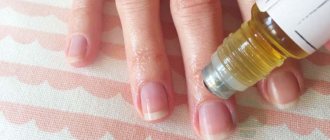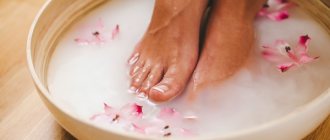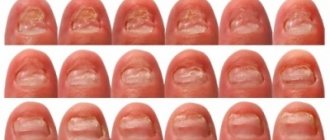With severe internal diseases, poor nutrition, and with age, nail growth slows down and its structure undergoes changes. Only a doctor can accurately determine the cause of the disorder based on the results of tests and microscopic examinations.
But to get an idea of what happens to your toenails or fingernails, you can use photos of different types of fungal diseases.
Causes of fungal infection
A person comes into contact with many pathogenic microorganisms every day, but not all of them become infected. Fungi are able to multiply when the body's defenses are reduced. The immune system is unable to respond to the problem in a timely manner, and infection begins.
The risk of developing infection increases when exposed to several factors simultaneously. The direct route of infection occurs through contact with a sick person. You just have to step barefoot in the footsteps of a sick person. Indirect routes of infection include contact with the patient’s belongings and shoes.
Provoking factors:
- microcracks, skin injuries;
- non-sterile manicure and pedicure instruments;
- common areas;
- excessive sweating;
- overweight;
- diabetes;
- chronic diseases;
- violation of metabolic processes;
- hormonal disbalance;
- lack of hygiene;
- wearing shoes out of season;
- nervous disorders, stress;
- elderly age;
- skin fungus.
The cause of the development of the disease must be sought not only in external factors, but also in internal ones. Fungi are opportunistic microorganisms that are constantly present on the skin, hair, nails, and other tissues, but their growth begins when exposed to certain factors. The cause of infection is not always external.
Hypertrophic
Hypertrophic onychomycosis is considered an advanced form of a normotrophic type of disease. The reasons for its occurrence are no different from the reasons for the appearance of other types of nail fungus.
The occurrence of hypertrophic onychomycosis is facilitated by contact with infected people, wearing uncomfortable shoes or poor hygiene. Other diseases that can cause this include HIV, hyperhidrosis and diabetes.
On the legs with hypertrophic onychomycosis, the thickness of the nail increases noticeably. Thickening of the plate can lead to a disease such as hyperkeratosis (when the disease occurs, the skin under the nail becomes keratinized).
The color of the plate changes, causing it to appear yellow or gray. Nails become opaque and dull. Onychogryphosis may occur, a fungus in which the nail becomes deformed and takes on the shape of a bird's claw.
With hypertrophic onychomycosis, the lateral parts of the nail are most affected. As a result, severe pain occurs in the fingers, preventing the person from moving normally.
Symptoms of the initial stage, photo
The disease can develop on the arms and legs. Has a similar clinical picture. It all starts with a slight change in the color of the nail plate on the big toe. A yellowish, gray tint appears. The location of the affected area may vary. Depends on the type of infectious agent.
Fungus on the hands, photo below. You can clearly see pathological changes and trace trends. Next comes the fungus on the feet, photo. The symptoms are similar. The disease develops according to a similar pattern.
Following the color change, at the initial stage, the integrity of the plate is compromised. The nail begins to crumble, break, peel. The fallen particles become a source of infection for other nails and other people. Despite increased fragility, the plate thickens. And a little later it begins to deform.
External changes in the nail plate are accompanied by severe itching, cracks in the skin around the nail, between the fingers. Redness, severe peeling. There is an unpleasant odor that detergents cannot overcome.
General symptoms of onychomycosis:
- change in the color of the nail plate;
- presence of stains;
- increased fragility;
- peeling;
- itching;
- inflammation of the skin around the nail;
- thickening, deformation of the nail plate.
However, the disease can develop in several directions, depending on the causative agent of the infection.
Regional onychomycosis
Regional onychomycosis is the initial stage of the disease. It is quite difficult to determine the disease at this stage.
What toenail fungus looks like depends on the degree of development of the pathology. Narrow gray lines gradually appear along the edges of the plate. The nail itself begins to fade. Small yellow spots appear in the center of the nail. The plate does not change thickness, but becomes brittle.
The nail is not completely affected. Only certain parts of it suffer. Therefore, the surface of the affected nail becomes checkered. You can see the gray matter under the nail, but it does not make the nail itself thicker.
Types of fungus
Doctors distinguish several types of pathological microorganisms that provoke the development of onychomycosis.
White superficial fungus
I provoke diseases Trichophyton mentagrophytes. They penetrate into the human body in several ways - through damaged cuticles, microcracks, side folds of nails, ridges, and upon contact with moisture. Most often, infection occurs in public places with a warm, humid environment - baths, saunas, steam rooms.
White superficial fungus affects the thumbs, toes, and little fingers. It develops less frequently on the hands. Initially, small white spots appear on the nail plate. Over time, their number increases, and the area of the spots changes upward. White color changes to yellow. The nail becomes brittle, often breaks, and becomes rough.
When the nail plate is infected with a white superficial fungus, it does not harden or peel off. But over time, the upper platinum becomes covered with a white, loose fur coat. If therapy is started in a timely manner, the pathology is easily treated, and the diseased nail does not fall off. However, this form of onychomycosis is often combined with other more dangerous ones.
Normotrophic fungus
The development of the disease begins with skin lesions between the toes and on the foot. Severe peeling, cracks of varying depths, and peeling of the epidermis appear. Characteristic symptoms are the presence of transparent blisters that burst over time, and in their place sores, redness, and ulcers appear. Unpleasant transformations are accompanied by a foul odor and unbearable itching, which intensifies in the evening.
In the absence of qualified therapy, the fungus spreads to the nails. Accumulates on the skin under the nail plate. It multiplies and deforms the nail from the inside. Normotrophic fungus causes several forms of onychomycosis:
- regional;
- hypertrophic;
- atrophic.
The plate turns yellow, thickens, peels off, and becomes deformed. The process is localized over the entire surface, from the edges, on the sides, in the center.
The fungus affects the toenails, spreads to the hands, and over time can spread to internal organs. In this situation, you should not hesitate to go to the doctor. To gain access to the painful microflora under the nail plate, it is removed surgically or gradually sawed off.
Interesting video:
Hypertrophic fungus
The disease is characterized by a large area of damage to the nail plate. The painful microflora is localized on the skin under the nail. Areas of the epidermis become inflamed, peel, flake, and become deformed. Due to this, the nail plate is deprived of access to oxygen and useful components, and slowly begins to deform.
A characteristic feature of this form of onychomycosis is a noticeable thickening of the platinum, yellowing of the entire nail, and the presence of gray areas. Nails become brittle and dull. Constantly crumbling. Over time, the deformation becomes so severe that the person feels pain and discomfort while walking. The nail itself takes on the shape of a claw.
The nail does not fall off completely, but constant peeling occurs. Yellow tissue grows back into place. Lack of therapy is dangerous for the disease to spread to all nails of the lower and upper extremities.
Atrophic fungus
This form of onychomycosis develops according to a slightly different pattern. Instead of compacting the nail plate, it gradually decreases. Painful microorganisms are localized on the skin of the big toe, less often the hand.
The nail initially changes color. A yellow tint and gray stripes appear. The top layer of the plate peels off and flakes off. Over time, nails begin to crumble. The infection affects the upper part of the nail, gradually approaching the place of growth. The layers of the nail platinum gradually become thinner and disappear. In their place, particles of exfoliated, rough skin are visible.
With atrophic fungus, the upper part of the nail suffers the most; even with severe, prolonged infection, the platinum does not peel off from the base or fall off.
Proximal fungus
It is quite rare. Infection occurs when the cuticle is damaged and a certain layer of skin is removed. The fungus is localized at the site of growth of the nail plate. A wide white spot appears. There, pathogenic microorganisms leave spores, mycelium, and make their move. The layer becomes loose and deformed.
The proximal fungus creates a seal around the cuticle and affects the new nail during the growth phase. The upper part of the diseased nail becomes dull over time and begins to peel. The infected nail falls off and a new one does not have the opportunity to grow.
Any form of onychomycosis at the initial stage causes a change in one direction or another in the structure of the nail and color. Any spots that weren't there before should alert you.
Stages of the disease
What toenail fungus looks like depends on the stage of the disease.
In medicine, it is customary to distinguish 3 main stages of its development:
- At the first stage, it is quite difficult to detect the presence of fungus. This is because there are no visible signs.
- Second stage. When moving to the second stage, the nails lose their shine and the color of the plate gradually begins to change. The nail becomes more brittle at the edges. You can already see small white spots or grooves, which will increase in size over time.
- The third stage is an advanced form of pathology, when a person ignored the disease for a long time and did not treat it. At this time, there is a huge risk of losing a nail. It begins to delaminate and break more and more.
Treatment of the initial stage of the fungus
The general principles of therapy are aimed at stopping the growth of pathogenic microorganisms, eliminating painful symptoms, and restoring the nail plate.
Antibiotic tablets are used to kill the fungus. The active components penetrate the bloodstream, spread throughout the body, and are localized in affected areas. They act specifically on fungi that cause onychomycosis.
If the nail plate becomes very compacted, experts strongly recommend removing it. At the initial stage of a fungal infection, a surgical procedure is avoided. Prescribed drugs that promote gradual peeling of the diseased nail.
The use of external agents is an auxiliary element of complex therapy. They are necessary to stop the spread of infection and infect others. The products glue together particles of fallen dead cells and kill fungal spores in them. From this side, special healing varnishes are most effective.
To speed up the detachment of a diseased nail, folk remedies are used - warm baths, compresses, rubbing. Treat nails with oils, peroxide, vinegar, and laundry soap.
To effectively combat a fungal infection, it is necessary to adhere to a diet, strengthen the immune system, and increase the body’s protective functions. Otherwise, the disease will return again.
Treatment methods
Before starting treatment for any form of onychomycosis, you must consult a dermatologist for diagnosis. Only after laboratory tests and determination of the size of the affected areas, further treatment of the patient is prescribed.
As a rule, local remedies and oral medications are used in the treatment of onychomycosis.
For more effective treatment, in addition to taking medications, it is recommended to treat personal belongings and common items to prevent re-infection.
Treatment is possible in the following ways:
- Physiotherapy. This procedure is prescribed to improve blood circulation in the extremities. Physiotherapy is used in combination with UHF and amplipulse effects on the lumbosacral and cervical regions. Laser therapy and diathermy are also used.
- In case of advanced disease, when the nail is deformed and peels off, doctors decide to remove the nail plate. This will further prevent the spread of fungus and allow the medications to work more effectively on a healthy surface.
Pharmacy products
The main methods of combating fungal diseases include antimycotics. They cause more harm to nail fungus, and therefore effectively treat the affected areas. Antimycotics are suitable for the treatment of almost all types of disease, with the exception of Candida (here treatment must be selected individually).
Dermatologists often prescribe the following antimycotics:
- Varnishes that can protect the nail from further development of the disease (Loceryl).
- Solutions that destroy fungus from the nail folds and from the plate itself (Exoderil).
- Ointments or gels that relieve itching and inflammation (Lamisil).
When local treatment does not fully produce the desired effect, oral medications are prescribed. The main difficulty of treatment with such drugs is the large number of contraindications and precautions. The effect of the drugs increases gradually.
The most common medications dermatologists prescribe are:
- Mikosist.
- Tecnazole.
- Terbizil.
- Irunin.
- Fluconazole.
ethnoscience
Traditional medicine can also be used in the treatment of fungal nail disease, but only in combination with other drugs.
Tea mushroom
To use it, you need to steam your feet. After which a small piece of mushroom is applied to the sore nail and wrapped with a bandage. The compress stays on all night and is removed in the morning.
Dead areas should be removed and then treated with any antiseptic. The course of treatment lasts several weeks.
Air
Calamus decoction can also become an assistant in the fight against nail fungus. This decoction should be taken 3 times a day. During the treatment period, it is necessary to trim rough skin and growing nails.
- To prepare the product, you need 2 tsp. Grind the rhizomes of the plant and pour boiling water (usually 100 ml is enough).
- Then, the rhizomes are boiled in water for no more than 1 minute.
- When the product has cooled, it is ready for use.
Due to the fact that the decoction has a bitter taste, it can be washed down with water.
Vinegar baths
Vinegar baths have a good effect only in the initial stages of the disease. In the future, they are used only with the permission of a doctor and together with other medications.
Vinegar baths soften the epidermis, improve blood circulation, and also transform the appearance of the feet.
Vinegar can be used in combination with the following ingredients:
- Soda. It noticeably softens the epidermis and improves the effect of the procedure as a whole. To prepare a solution for the procedure, you need to stir 0.5 tbsp into 3 liters of water. vinegar with 2 tbsp. l. soda
- Essential oils. This component shortens the course of treatment several times. For one vinegar bath you need 3 drops of oil.
- Glycerol. For 3 liters of water take 9 tbsp. l. vinegar and 3 tbsp. l. glycerin. When preparing the solution, glycerin is first added to the water for better dilution. Glycerin in vinegar baths helps moisturize the skin of the feet.
Baths can also be used as a preventive measure.
There are a number of contraindications for which vinegar baths cannot be used:
- Oncology.
- Wounds, ulcers and scratches on the legs.
- Individual intolerance.
- Thrombophlebitis.
- Pregnancy.
- Cardiovascular system disorders.
- Age up to 10 years.
Before carrying out the procedure, you must complete 3 steps:
- Carry out a sensitivity test. A small area near the elbow is moistened with the prepared solution. After 15 min. There should be no allergic reactions (itching, burning, redness).
- Before the procedure, the legs must be steamed and affected tissue removed.
- After the procedure, you need to rinse your feet and dry them well. You cannot put any weight on your legs for 2 hours.
- The duration of the procedure is 10-20 minutes.
In general, treatment with vinegar baths lasts 2-3 weeks.
Tea tree oil
The use of tea tree oil promotes effective healing of the affected nail. During the procedure, the oil should be applied under the nail at the rate of 1 drop per 1 nail. The procedure is carried out 3 times a day. The treated areas of the nail should be covered with a plaster, so the effect of the treatment will be greater.
Iodine treatment
Iodine is widely used in the fight against nail fungus. It is best to use a 5% solution for the procedure. All that is needed for treatment is to apply an iodine solution to the affected area of the nail 2 times a day.
When applying iodine, you may feel a slight burning sensation. If the burning sensation is mild and does not cause discomfort, everything is fine. If the pain is severe, then iodine treatment should be stopped immediately. The course of treatment with iodine solution is long - 2-3 months.
An advanced stage of the disease can lead to more serious consequences. Whatever method of self-treatment the patient chooses, at the first signs, it is necessary to contact a specialist. Based on what nail fungus looks like, your doctor will be able to prescribe proper treatment. Onychomycosis on the legs can be treated quite quickly and effectively with the right approach.
Author: Vladimir Kharlamov
Folk remedies for nail fungus
To treat onychomycosis, baths, compresses, and lotions are used. Medicines are purchased at a pharmacy or prepared independently. To increase efficiency, several treatment options are combined at once. The essence of the traditional treatment process is to soften the nail plate, remove the dead layer, apply a healing composition, and ensure deep penetration of the active components.
- Laundry, tar soap . Turn into shavings, dissolve in water, lower your feet for 20 minutes. Or soap your fingers, sprinkle with salt, baking soda, massage, and leave for 15 minutes.
- Table vinegar, apple . Add to bath water or make lotions. Soak cotton wool or gauze in concentrated vinegar and apply it to the affected area overnight. In just a few procedures, the diseased nail will fall off and a new one will begin to grow healthy.
- Birch tar . Add to baby cream. Apply after a bath with cleansing procedures.
- Garlic. They turn it into mush. Apply a thick layer to the nail, bandage it, or cover it with cling film and fix it with a bandage. Cotton socks are worn over the top. Repeat every evening.
- Iodine . Place in a bath of sea salt. Remove the top layer of the nail plate with a nail file, treat it with peroxide, and apply iodine on top. This component prevents the detachment of particles and stops the spread of infection.
- Celandine. They are used in different variations; oil lotions are the most effective. After cleansing procedures, apply a cotton wool soaked in celandine oil to the affected nail. The procedure is done before bed every day.
- Fukortsin . Treat the nail and put a plastic bag over it. Leave overnight or for 4 hours during the day. Therapy within a week gives a noticeable positive result.
- Propolis . Use alcohol tincture. Moisten a cotton swab, wipe the nail several times a day, and apply a compress overnight.
- Citrus juice . Every evening after the bath, you need to wipe all your nails with juice from tangerine, lemon, and orange. The acid softens the top layer, promotes the penetration of active components, and stops the growth of fungi. After the juice, you can apply any healing agent.
- Tea tree oil . Draw it into a syringe and inject it under the nail. Or moisten a cotton wool, apply it as a compress at night, and simply wipe it during the day.
All the products presented above have been tested repeatedly, recognized as the most effective, and compete with modern professional drugs.
Routes of infection
Foot fungus is a highly contagious disease. Pathology is caused by pathogenic fungi, yeast-like or mold. Fungal microflora loves a humid and stuffy environment, so it actively multiplies in showers, swimming pools, and gyms.
Fungal infection usually occurs due to neglect of personal hygiene. Visiting a public shower without slippers, contacting your feet with the floor in the gym, walking barefoot near a public swimming pool - all this leads to infection with fungus.
Fungal spores remain viable for a long time. They can settle on carpets, bed linen, towels, and shoes. In addition, without proper disinfection, spores on towels can live for up to several months. Regular washing in a washing machine at medium temperatures does not kill the fungus.
You can become infected while visiting, walking barefoot on a carpet with which an infected person has been in contact. Spores from fleecy fabrics easily fall on the skin. Another source of infection is trying on someone else's shoes. Even new shoes from a store can be a source of infection, since it is impossible to trace who tried on this pair before purchase, and in stores shoes are usually not disinfected after each client. Unfortunately, not all people use special socks for trying on, so fungal spores may remain on a new pair of shoes.
It is even easier to get the fungus if one of the relatives living in the same apartment is infected. To prevent the spread of pathogenic microflora, you should carefully adhere to the rules of hygiene, and not all patients do this. Fungal spores remain on the bathroom rug, directly on the surface of the bathtub or shower stall, and end up on the belongings of other household members if the sick person’s clothes are washed in the washing machine at the same time as other things.
If a person with a fungus tries on shoes on bare feet, the next buyer can easily become infected
Medical supplies
To treat onychomycosis, tablets, creams, ointments, and varnishes are used. The course of therapy at the initial stage of the disease does not exceed 10 days. But some products are recommended for prevention until a new nail grows.
Pills
Antifungal drugs kill pathogens, thereby relieving a person of unpleasant symptoms. The drugs have contraindications and side effects, so it is recommended to consult with specialists before starting therapy. In most cases, the course consists of 1 tablet of a certain dosage.
- Futsis;
- Ketoconazole;
- Fluconazole;
- Terbinafine;
- Itraconazole
To increase the effectiveness of the tablets, it is recommended to use external agents with the same name in parallel.
Ointment, cream
The drug is applied several times a day, always in the evening after a steam bath, removing keratinized areas. The duration of therapy is about 10 days. The ointment, as an independent remedy, can be used without tablets at the initial stage of onychomycosis.
In addition, there are special ointments that promote rapid detachment of the infected nail. They are used every other day. Stop therapy after complete removal of the infected plate.
- Clotrimazole;
- Mycostop;
- Ureaplast;
- Loceryl;
- Triderm;
- Pimafucin;
- Lamisil.
Antifungal ointment is used until the nail plate is completely restored.
Varnish
Unlike ointment, varnish is able to penetrate into the deep layers of the nail plate and fills cracks. Creates a protective film on the surface of the nail, preventing the spread of infection. The varnish is applied 1-2 times a week; decorative cosmetics are allowed to be applied on top. Duration of treatment is up to 6 months. Unpleasant symptoms disappear within a week.
- Oflomelid;
- Oflomil;
- Loceryl;
- Batrafen;
- Demicten;
- Lamisil.
The product in the form of a varnish is easy to use, has no contraindications, and can be used for a long time.
Candidal onychomycosis
This type of disease occurs due to a decrease in the protective properties of the skin and weak immunity. Candida fungi, which live in the intestines and genitourinary tract, begin to multiply quickly and colonize the nail plates. The disease is most common in the female half of the population. People who work as waiters and dishwashers most often suffer.
At the beginning of the disease, the fungus affects the nail fold and the skin next to it. The skin turns red and begins to become inflamed. The roller swells, the skin on it practically disappears. If the disease is not treated, it can develop into a chronic condition and peeling of the skin in the area of the nail and nail fold will remain forever.
Refusal of treatment may cause nail deformation. It starts from the roller to the center of the nail. It becomes thinner and with slight pressure on the plate, pus may be released. On the plate itself, wavy white stripes are clearly visible.
There is proximal candidal onychomycosis. The difference is that the nail fold does not suffer. Small white dots located under the nail help identify the disease.
The third form of candidal onychomycosis is distal. The fungus affects the remote part of the nail and moves towards its middle. The color of the plate changes and the nail becomes thicker. Hyperkeratosis occurs under the nail, causing the nail to rise.
Prevention
You can avoid the disease by following certain rules:
- go for manicures and pedicures in salons with a good reputation;
- wear rubber slippers in public places - shower, swimming pool, bathhouse, sauna;
- monitor foot hygiene;
- avoid excessive sweating;
- treat diseases in a timely manner, prevent chronic progression;
- strengthen the immune system.
At the first symptoms of the disease, visit a specialist and take emergency measures before the fungi have time to destroy the nail.
Interesting video:
The origin of toenail fungus
Before starting active treatment, it is necessary to eliminate the causes of the disease and reduce the negative influence of environmental factors:
- A humid, warm environment is the optimal condition for the growth of bacteria; after walking you need to dry your shoes, and completely avoid synthetic socks.
- Fungus often occurs due to a weak immune system; you can step on any surface with unprotected feet and acquire the disease. For these purposes, multivitamin complexes are taken.
- Extension of artificial nails is one of the causes of fungus; the procedure should be limited to once every six months.
- The most dangerous fungus is onychomycosis, caused by living spores. They can be in a passive state and then suddenly become active. You can become infected with this form of pathology in solariums, swimming pools, baths, gyms, or through someone else's shoes.
The severity, form and nature of its course depend on the cause of the disease. Accordingly, the dermatologist can adjust the complex of therapy for each type of fungus.
Feedback from our readers
You can leave your reviews and recommendations for treating the initial stages of nail fungus in the comments below, they will be useful to other users!
Oleg : “It turned out to be an interesting situation. There was a fungus on my feet with all the obvious signs. He treated me with all sorts of lotions and ointments. But one day a miracle happened. I woke up and there was nothing on my skin except a pink spot. I connect this with one incident. In a basin of rainwater lay an ax with a birch ax handle. I abandoned it a long time ago, the water there was already green, the basin was galvanized with a coating. He started to take out an ax and got dirty. At the same time I rinsed my feet. This moment turned out to be healing. I can’t understand what exactly worked.”
Sergei : “I came home, went to the shower, and wanted to wash my feet. I live as a bachelor, I ran out of soap and didn’t have time to buy it. I took Fairy to wash the dishes. In the morning I was surprised that the fungus on the nails became almost invisible. The next evening I took the detergent again. I got rid of the fungus in a week.”
Karina : “I got infected at the salon and had a bad pedicure. I treated the fungus for six months. Cream, ointment, tablets. I just set my stomach. Then I bought Batrafen varnish, and things got better. You just paint your nails and the product does its job. It’s interesting that I strengthened my immunity in every possible way, but my body did not overcome the fungus on its own.”
Normotrophic
Normotrophic onychomycosis occurs for the same reasons as other types of fungus. Microorganisms enter the skin, after which they penetrate from its surface through small damage deep into the nail plate.
With normotrophic onychomycosis, in the first days of the disease, the color of the nail does not change completely, but only in patches. The sides and ends of the nail become white, yellow or gray. The nail plate loses its shine and becomes dull. Over time, the color of the nail changes completely, but its thickness does not decrease.
Disinfection and personal hygiene
Having noticed that the nail has changed color and suspecting the initial form of the fungus, comparing the symptoms with the photo, it is necessary to attend to complex treatment. To effectively get rid of fungus, you need to:
- thoroughly disinfect socks and shoes every day;
- boil bed linen and towels;
- Clean the bathtub thoroughly after bathing.
All wardrobe items that came into contact with the affected nails during the day must be boiled in a soapy solution in the evening. It is better to use laundry soap. Shoes should be wiped daily with an antiseptic or a special antifungal solution.
Domestos can be used to disinfect the bathtub. This household chemical kills fungal spores.











